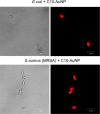Functional gold nanoparticles as potent antimicrobial agents against multi-drug-resistant bacteria
- PMID: 25232643
- PMCID: PMC4212784
- DOI: 10.1021/nn5042625
Functional gold nanoparticles as potent antimicrobial agents against multi-drug-resistant bacteria
Abstract
We present the use of functionalized gold nanoparticles (AuNPs) to combat multi-drug-resistant pathogenic bacteria. Tuning of the functional groups on the nanoparticle surface provided gold nanoparticles that were effective against both Gram-negative and Gram-positive uropathogens, including multi-drug-resistant pathogens. These AuNPs exhibited low toxicity to mammalian cells, and bacterial resistance was not observed after 20 generations. A strong structure-activity relationship was observed as a function of AuNP functionality, providing guidance to activity prediction and rational design of effective antimicrobial nanoparticles.
Keywords: MDR E. coli; MRSA; antimicrobial agents; gold nanoparticles; mode of action; structure−activity relationship; uropathogens.
Figures




References
-
- Neu H. C. The Crisis in Antibiotic-Resistance. Science 1992, 257, 1064–1073. - PubMed
-
- FY15 Detect and Protect Against Antibiotic Resistance Budget Initiative; Centers for Disease Control and Prevention: Atlanta, GA, 2003, http://www.cdc.gov/drugresistance/threat-report-2013/pdf/FY15-DPAR-budge....
-
- Spellberg B.; Powers J. H.; Brass E. P.; Miller L. G.; Edwards J. E. Trends in Antimicrobial Drug Development: Implications for the Tuture. Clin. Infect. Dis. 2004, 38, 1279–1286. - PubMed
-
- Alanis A. J. Resistance to Antibiotics: Are We in the Post-Antibiotic Era?. Arch. Med. Res. 2005, 36, 697–705. - PubMed
-
- O’Connell K. M. G.; Hodgkinson J. T.; Sore H. F.; Welch M.; Salmond G. P. C.; Spring D. R. Combating Multidrug-Resistant Bacteria: Current Strategies for the Discovery of Novel Antibacterials. Angew. Chem., Int. Ed. 2013, 52, 10706–10733. - PubMed
Publication types
MeSH terms
Substances
Grants and funding
LinkOut - more resources
Full Text Sources
Other Literature Sources
Medical
Molecular Biology Databases

